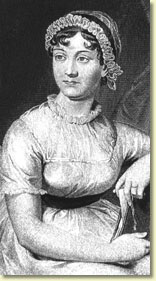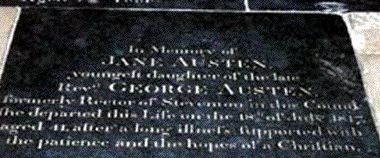Jane
Austen (1775-1817)
Dates of Birth/Death:
1775-1817
Gender:Female
Literary Periods: Romantic
Period 1780-1837; Eighteenth Century, 1700-1799; Nineteenth Century 1800-1899
Literary Movements: Romanticism
1780-1837

image copiryght:
©http://www.openwold.co.uk/austen
BIOGRAPY
AUSTEN,
JANE (December 16, 1775-July 18, 1817), novelist, was born at
Steventon, Hampshire,
seventh of the eight children
of the Rev. George Austen. Her mother was Cassandra Leigh, a niece
of the famous Rev.
Theophilus Leigh, master of Balliol College, Oxford. The situation of the
Austens,
a large family of gentle
lineage and no fortune, was similar to that bestowed by Miss Jane upon
some of her
own characters. Like
many clergymen of the time, Mr. Austen supplemented his income by farming
and tutoring.
The Steventon parsonage
is described as having been more commodious than most, but, with eight
children
in addition to the
small boys who were taken to board, it cannot have seemed so to its inhabitants.
It may have
been exigencies of
space which caused Jane, aged six, and Cassandra, aged nine, to be sent
away to a
school at Oxford, later
to Southampton, in 1782. Here both girls fell dangerously ill of fever.
They were next
placed under Madame
Latourelle, an old lady with a cork leg who conducted the Abbey School
at Reading.
Like the school in
Emma, it was a place "where girls might be sent to be out of the way, and
scramble
themselves into a little
education without any danger of coming back prodigies." This experiment
lasted but
a short time and thereafter
the Austens educated their daughters at home.
It was a lively, cheerful
family, given to novel-reading and charades. Mr. Austen's children took
part in the
theatrical entertainments
which were given before his pupils went home on vacation. In the eighteenth
century
a parson's family was
not limited in its enjoyment of whatever worldly diversions were available,
but roads were
bad and social gatherings
few enough so that on the whole country life was quiet at best. Jane had
plenty
of time to wield her
pen for her own amusement. Copy-books from her fourteenth year, containing
sketches
and stories which precociously
shadow forth the splendid vein of irony she was later to develop, are most
remarkable in the sure
critical sense which they display. The youthful essays of genius are commonly
slavish
imitations of current
favorites. Jane Austen recognized and pilloried the faults of the popular
novel before she
was fifteen. Love and
Friendship is the most brilliant of the juvenilia.
Between
1795 and 1798 she had completed three novels. A London publisher, Cadell
by name, has achieved
a certain immortality
by his refusal of First Impressions. It was ultimately called Pride and
Prejudice. Too much
stress has perhaps
been laid upon the placidity of Jane Austen's life and the fact that she
could not have
worked in any other
genre than the one she created. It cannot be said, however, that the stirring
events of her
period did not touch
her. Two of her brothers were naval officers who saw active service, and
living with the
family from Jane's
tenth year was her cousin, the Comtesse de Feuillade, whose husband was
guillotined
in 1794. But it is
true that Miss Austen never trifled with situations outside her own experience.
She advises
her niece, who is writing
a novel, "Let the Portmans go to Ireland, but, as you know nothing of the
manners
there, you had better
not go with them." There was one element in Miss Austen's life which might
have been
grist to another writer.
This was her second brother George, "mental invalid," who lived over sixty
years. He is
usually not mentioned
in biographies of the novelist, but his existence may have contributed
to her impatience
with the vogue for
treating insanity as an ingredient of romance, and it certainly added to
the financial burdens
of the family.
Jane
Austen was never a bluestocking. In her youth at Steventon she is described
as having been something
of a flirt. She was
tall, slender, and graceful, "a clear brunette with a rich color, hazel
eyes, fine features and
curling brown hair"
whom no one outside her immediate family suspected of having literary ambitions.
The only
authentic portrait
of her, from the pencil of Cassandra, while of rather indifferent composition
shows a primly
elfin face with a small,
determined mouth that is quite appealing. She dearly loved a ball and was
as impatient
of poor dancing as
she was of poor sense. She did exquisite needlework and had other practical
domestic
virtues. "I always
take care to provide such things as please my own appetite, which I consider
as the chief
merit in housekeeping."
The
years after 1798 seem to have been particularly quiet and contented ones.
Mr. Austen gave up his school
and the parsonage expanded
enough to allow the devoted sisters a sitting-room of their own. Here were
Jane's
piano and writing materials
and Cassandra's drawing implements. This felicity, however, did not long
endure.
In 1801 Mr. Austen
made the Steventon living over to his eldest son James, and prepared to
settle with his
wife and daughters
at Bath. It may have been because these daughters were unmarried that the
elderly retired
clergyman elected to
spend his declining years in this populous and expensive watering-place.
Jane was
twenty-six at the time,
Cassandra, twenty-nine, and both doomed to spinsterhood unless something
immediate
was accomplished. Jane
had had several romantic attachments while at Steventon, but nothing serious
had
ever developed. Cassandra
had been engaged to marry a former pupil of her father's, Thomas Craven
Fowle.
He went out to the
West Indies as chaplain to his cousin Lord Craven's regiment and died there
of yellow fever.
During the summer of
1801 the Austens toured South Devon and Jane is reported to have met and
fallen in
love with a clergyman
named Blackall. The attraction was mutual, but before it reached a formal
engagement
the gentleman died.
This tragedy not only prevented Jane's acceptance of another unnamed eligible
who
offered himself the
following year but caused a break in her literary productivity. Told many
years after Jane's
death by Cassandra,
this touching story suffices well enough for those of the author's admirers
who insist upon
a serious love affair
for their darling, but it bears a strange resemblance to the account of
Cassandra's own
broken heart.
It
was in 1802 that Jane had the felicity of selling her first manuscript.
Susan, posthumously published as
Northanger Abbey, was
sold to Crosbie of London for L 10. The Gothic novel which it parodied
was still too
popular for Miss Austen's
treatment of it to be appreciated and Crosbie failed to publish. The Watsons
was
begun about this time,
dropped, and never finished.
Mr.
Austen's death in 1805 left his wife and daughters with an income of only
L 210 a year between them.
This was raised by
the brothers to L 450, a sum barely adequate in a day when living costs
were high, and
considering that Mrs.
Austen's brother and one of her sons were extremely wealthy. Jane had no
need to draw
upon imagination for
her portrayals of rich relatives and their attitude toward less fortunate
kinsfolk. Further to
economize it was decided
that the ladies should go to live in the recently established household
of Francis
Austen at Southampton.
It cannot have been a comfortable situation for any one concerned. Francis
Austen,
himself barely a year
older than Jane, was called to sea, leaving his young wife to anticipate
an infant in
company with newly
acquired female relatives whose ages ranged from thirty to seventy.
Happily
for Jane the arrangement did not last many years. In 1808 the wealthy brother
Edward lost his wife and
by reason of this bereavement
had his attention turned toward his own family. He offered them then the
use of a
house on his estate
at Chawton near Alton. Here after eight unsettled years Jane could compose
her mind to
write. Revising Elinor
and Marianne, she sold it as Sense and Sensibility. Published in 1811,
it was an
immediate success.
Encouraged by this and the further popularity of Pride and Prejudice, she
wrote, almost
as if she knew her
time was short, Mansfield Park, Emma, and Persuasion in rapid succession.
Domestic
pursuits and the entertainment
of her multitude of nephews and nieces occupied her. She used the common
sitting-room as her
work place, making as her sole stipulation that the squeak should not be
taken out of the
swinging door because
it gave her warning in time to conceal her manuscript.
In
1815, while Jane was in London correcting proof on Emma, Henry Austen whom
she was visiting there fell
dangerously ill. This
was Jane's fourth and her favorite brother. His wife, the aforementioned
Eliza de Feuillade,
was dead and it was
Jane who nursed him back to health.
In
1816 Henry Austen bought back Northanger Abbey for L 10, the amount originally
paid Jane in 1802. She
had written Crosbie
in 1809, urging him to publish the book, and his only reply had been a
threat to sue if the
manuscript was offered
elsewhere. It must have been with considerable satisfaction that Henry
concluded
the interview by informing
the publisher that the manuscript he had just relinquished was by the author
of Pride
and Prejudice!
Now
at the fullness of her powers Jane's health began to decline. Cassandra
took her to Winchester to be
under the care of a
doctor friend of the family, but her ailment was never properly diagnosed.
Some sprightly
verses, written a day
or two before her death, show that her sense of humor never failed. She
died in her
sister's arms and was
buried in Winchester Cathedral.

Jane
Austen grave at Winchester Cathedral, England
©http://www.bol.net/overseer5/austen.html
Generations of readers have marveled at the modernity of her work. Excepting
an occasional quaintness
of phraseology, the
savor of Jane Austen's novels is as vivid today as it was when they were
new. Regiments
of critics have idolized
her. Macaulay places her "among the writers who have approached nearest
to the
manner of the great
Master" {Shakespeare}. Her creations have come alive for others than Macaulay.
Tennyson,
on a visit to Lyme Regis, scorned its historical associations, saying "Don't
talk to me of the Duke
of Monmouth. Show me
the exact spot where Louisa Musgrove fell!" Professor Saintsbury said that
"not even
Scott's or Thackeray's
characters dwell in the mind more securely." Her portraiture, "distinctly
satirical . . . has
even been accused of
a touch of cruelty; but this only gives flavor and keeping quality. . .
. She is the mother of
the English nineteenth
century novel as Scott is the father of it."
(P. B. S.)
Adapted from
data developed by the H.W. Wilson Company, Inc.
Copyright
© 1996-99 Chadwyck-Healey Ltd and
Chadwyck-Healey Inc.


Academic year 1999/2000
©a.r.e.a./Dr. Vicente Forés
López
© Sandra Esplugues Mullor
Universitat de València
Press


